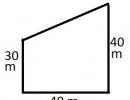Transformation of liquid into solid. Aggregate states of matter. Evaporation - vaporization occurring from the surface
- Solid state
- Liquid state
- Gaseous state
- Change in state of matter
Chemistry studies matter. What is “substance”? Matter is anything that has mass and volume. A substance can be in one of three states of aggregation: solid, liquid, gaseous.
1. Solid state
Particles (molecules) in a solid are combined into a rigid repeating structure - crystal lattice. Particles in the crystal lattice undergo small vibrations around the centers of equilibrium. A solid has form And volume.
2. Liquid state
Unlike solids, liquids do not have a specific shape, but they do have volume. This is explained by the fact that in liquids the particles are at a greater distance from each other than in solids and move more actively.
Since particles in liquids are located less densely than in solids, they cannot form a crystal lattice, therefore liquids do not have a specific shape.
3. Gaseous state
In gases, particles are located at even greater distances than in liquids. Moreover, the particles are constantly in chaotic (disorderly) motion. Therefore, gases tend to uniformly fill the volume provided to them (hence the fact that gases do not have a specific shape).
4. Change in state of matter
Let's take a trivial example and follow the process of changing the state of water.
In its solid state, water is ice. The temperature of the ice is less than 0 o C. When heated, the ice begins to melt and turn into water. This is explained by the fact that ice particles located in the crystal lattice begin to move when heated, as a result of which the lattice is destroyed. The temperature at which a substance melts is called "melting point" substances. The melting point of water is 0 o C.
It should be noted that until the ice is completely melted, the temperature of the ice will be 0 o C.
| During phase changes of a substance, the temperature remains constant |
After the ice has completely turned into water, we will continue heating. The water temperature will rise, and the movement of particles under the influence of heat will accelerate more and more. This happens until the water reaches its next state change point - boiling.
This moment occurs when the bonds of water particles are completely broken and their movement becomes free: water turns into steam.
| The process of a substance changing from a liquid to a gaseous state is called boiling |
The temperature at which a liquid boils is called "boiling point".
Please note that boiling point depends on pressure. At normal pressure (760 mm Hg), the boiling point of water is 100 o C.
By analogy with melting: until the water completely turns into steam, the temperature will remain constant.
Summarize. As a result of heating, we obtained different phase states of water:
Ice → water → steam or N 2 0 (t) → N 2 0 (g) → N 2 0 (g)
What happens if we start cooling water vapor? You don’t have to be a “best student” to guess that the reverse process of phase changes in water will take place:
Steam → water → ice
There are some substances that go from a solid state directly to a gaseous state, bypassing the liquid phase. This process is called sublimation or sublimation. This is how, for example, “dry ice” (nitrogen dioxide CO 2) behaves. When it is heated, you will not see a drop of water - the “dry ice” will seem to evaporate before your eyes.
The reverse process of sublimation (the transition of a substance from a gas to a solid state) is called desublimation.
Depending on conditions, bodies can be in a liquid, solid or gaseous state. These states are called aggregate states of matter .
In gases, the distance between molecules is much greater than the size of the molecules. If the gas is not interfered with by the walls of the container, its molecules fly apart.
In liquids and solids, the molecules are located closer together and therefore cannot move far away from each other.
The transition from one state of aggregation to another is called phase transition .
The transition of a substance from solid to liquid is called melting , and the temperature at which this occurs is melting point . The transition of a substance from a liquid to a solid state is called crystallization , and the transition temperature is crystallization temperature .
The amount of heat that is released during crystallization of a body or absorbed by a body during melting, per unit mass of the body, is called specific heat of fusion (crystallization) λ:
During crystallization, the same amount of heat is released as is absorbed during melting.
The transition of a substance from a liquid to a gaseous state is called vaporization . The transition of a substance from a gaseous state to a liquid state is called condensation . The amount of heat required for vaporization (released during condensation):
| Q = Lm, |
Vaporization occurring from the surface of a liquid is called evaporation . Evaporation can occur at any temperature. The transition of liquid into vapor, occurring throughout the entire volume of the body, is called boiling , and the temperature at which the liquid boils is boiling point .
Finally, sublimation is the transition of a substance from a solid state directly to a gaseous state, bypassing the liquid stage.
If other parameters of the external environment (in particular, pressure) remain constant, then the body temperature does not change during the process of melting (crystallization) and boiling.
If the number of molecules leaving the liquid is equal to the number of molecules returning to the liquid, then we say that dynamic equilibrium has occurred between the liquid and its vapor. Vapor that is in dynamic equilibrium with its liquid is called
We live on the surface of a solid body- the globe, in structures built from solids,- houses. Our body, although containing approximately 65% water (the brain is 80%), is also solid. Tools and machines are also made from solids. Knowing the properties of solids is vital.
IN§ 2.6 the molecular structure of crystalline solids was briefly described. Now we will take a closer look at their properties and structure.
Crystals
If you examine grains of sugar, salt, copper sulfate, naphthalene, etc. with a magnifying glass or microscope, you will notice that they are limited by flat, as if polished, edges. The presence of such natural faces is a sign that the substance is in a crystalline state. A crystal* is a body of a certain geometric shape, bounded by natural flat edges.
* From the Greek word krystallos - literally: ice.
Single crystals and polycrystalline bodies
A body that is one crystal is called a single crystal.
Figure 8.1 shows a large single crystal of quartz (rock crystal). A small grain of granulated sugar is also a single crystal. By taking great precautions, it is possible to grow a metal single crystal of large sizes.
Most crystalline bodies consist of many small crystals randomly located and fused together. Such bodies are called polycrystalline. All metals and minerals are polycrystalline. A piece of sugar is also a polycrystalline body.
Crystal shape and size
Crystals of different substances have different shapes. Figure 8.2 shows crystals: rock salt 1, beryl 2, diamond 3, grenade 4, quartz 5, tourmaline 6, emerald 7 and calcite 8. One of the types of ice crystals that form the bizarre shapes of snowflakes (Fig. 8.3) is a regular hexagonal prism (Fig. 8.4).



The sizes of the crystals are also varied. Some crystals are large and easily visible to the naked eye, while others are so small that they can only be viewed through a microscope.
The sizes of polycrystalline crystals can change over time. Thus, small crystals of iron and steel turn into large ones. This transition is accelerated by impacts and shocks. It constantly occurs in railway rails, car axles, and steel bridges, causing the strength of these structures to decrease over time.
Polymorphism
Many bodies of the same chemical composition in the crystalline state, depending on conditions, can exist in two or more varieties (modifications). This property is called polymorphism (multiformity). Ice, for example, has up to ten different modifications that are obtained in laboratories. In nature, only one species is found (see Fig. 8.4).
Carbon polymorphism is of particular importance for technology - carbon crystallizes in two modifications: graphite and diamond. Graphite is a soft material with a matte black color. For example, pencil leads are made from it. Diamond is completely different from graphite. It is a transparent and very hard crystal. At a temperature of about 150 °C (when heated in a vacuum), diamond turns into graphite. To turn graphite into diamond, it must be heated to 2000 °C under a pressure of 1010 Pa. Currently, industrial production of artificial diamonds has been mastered. Man-made diamonds are widely used in various cutting tools.
Any body can be in different states of aggregation at a certain temperature and pressure - in solid, liquid, gaseous and plasma states.
For a transition from one state of aggregation to another, it occurs under the condition that the heating of the body from the outside occurs faster than its cooling. And vice versa, if the cooling of the body from the outside occurs faster than the heating of the body due to its internal energy.

When transitioning to another state of aggregation, the substance remains the same, the same molecules will remain, only their relative arrangement, speed of movement and forces of interaction with each other will change.
Those. a change in the internal energy of the particles of a body transfers it from one phase of the state to another. Moreover, this state can be maintained in a wide temperature range of the external environment.
When changing the state of aggregation, a certain amount of energy is needed. And during the transition process, energy is spent not on changing the body temperature, but on changing the internal energy of the body.
Let us display on the graph the dependence of body temperature T (at constant pressure) on the amount of heat Q supplied to the body during the transition from one state of aggregation to another.

Consider a body of mass m, which is in a solid state at a temperature T 1.
The body does not immediately transition from one state to another. First, energy is needed to change internal energy, and this takes time. The rate of transition depends on the mass of the body and its heat capacity.
Let's start heating the body. Using formulas you can write it like this:
Q = c⋅m⋅(T 2 -T 1)
The body must absorb so much heat in order to heat up from temperature T1 to T2.
Transition from solid to liquid
Further, at the critical temperature T2, which is different for each body, intermolecular bonds begin to break down and the body passes into another state of aggregation - liquid, i.e. intermolecular bonds weaken, molecules begin to move with greater amplitude, greater speed and greater kinetic energy. Therefore, the temperature of the same body in a liquid state is higher than in a solid state.
In order for the entire body to pass from a solid to a liquid state, it takes time to accumulate internal energy. At this time, all the energy goes not to heating the body, but to the destruction of old intermolecular bonds and the creation of new ones. Amount of energy needed:
λ - specific heat of melting and crystallization of a substance in J/kg, different for each substance.
After the entire body has passed into a liquid state, this liquid again begins to heat up according to the formula: Q = c⋅m⋅(T-T 2); [J].
Transition of a body from liquid to gaseous state
When a new critical temperature T 3 is reached, a new process of transition from liquid to vapor begins. To move further from liquid to vapor, you need to expend energy:
r is the specific heat of gas formation and condensation of a substance in J/kg, different for each substance.
Note that a transition from the solid state to the gaseous state is possible, bypassing the liquid phase. This process is called sublimation, and its inverse process is desublimation.
Transition of a body from a gaseous state to a plasma state
Plasma- a partially or fully ionized gas in which the densities of positive and negative charges are almost equal.
Plasma usually occurs at high temperatures, from several thousand °C and above. Based on the method of formation, two types of plasma are distinguished: thermal, which occurs when gas is heated to high temperatures, and gaseous, which is formed during electrical discharges in a gaseous environment.
This process is very complex and has a simple description, and it is not achievable for us in everyday conditions. Therefore, we will not dwell on this issue in detail.
Back forward
Attention! Slide previews are for informational purposes only and may not represent all the features of the presentation. If you are interested in this work, please download the full version.
Goals: formation of the concept of melting and crystallization of bodies, melting temperature and crystallization; developing the ability to apply acquired knowledge to solving simple problems, developing students’ horizons, nurturing interest in the subject, nurturing a comprehensively developed personality.
Necessary equipment: Teacher's workstation, physics lessons from Cyril and Methodius for 8th grade, pieces of ice, candle, matches.
Explanations: Student responses are in italics in the text.
Lesson plan:
- Organizing time.
- Learning new material.
- Consolidation.
- Homework.
- Lesson summary.
DURING THE CLASSES
1. Organizational moment
– Today in the lesson we will talk about the different states of matter, find out under what conditions a substance can be in one state or another and what needs to be done to transform a substance from one state to another.
2. Learning new material
– Let’s look at the pictures (slide 2). What do you think they have in common?
– The pictures show water in three different states: solid, liquid and gas.
- Right. Not only water, but also any other substance has three states. What are these states called?
–
– Can a substance change from one state to another? For example, is it possible to turn ice into water?
– Yes.
- How to do this?
– You need to heat it up.
-You're almost right. It would be more correct to say that we impart a certain amount of heat to the ice. Then what is the amount of heat?
– The amount of heat is the energy that a body receives or gives off during the process of heat transfer.
– What is internal energy?
– Internal energy is the energy of movement and interaction of particles that make up the body.
- Let's conduct an experiment. Let's leave one piece of ice on the plate and see what happens to it, and transfer a certain amount of heat from the candle to the second. Which piece of ice turns to water faster and why?
– In the second case, the process of transition of ice into water occurs faster, since the second piece of ice receives more heat from the candle than the first piece from the environment.
- Right. This means that the piece of ice that has been given more energy turns into water faster.
– Find in the textbook (p. 31) what is the name of the process of transition of a substance from a solid to a liquid state?
Process the transition of a substance from solid to liquid is called melting (slide 3)
- This is the topic of our lesson. Let's write it down in a notebook - Melting bodies.
– Let’s look at the melting process using a fragment (physics lessons from Cyril and Methodius for grade 8). Your job is to notice whether the temperature changes during this process.
– The temperature does not change during the melting process.
- Right. Now find in the textbook (p. 32) what is the name of the process of transition of a substance from a liquid to a solid state?
The transition of a substance from a liquid to a solid state is called solidification, or crystallization (slide 4)
– Let’s consider this process with the help of a fragment (electronic physics lessons by Cyril and Methodius for grade 8). Did the temperature change throughout the curing process?
– The temperature did not change during the hardening process.
– Let us remember that during the process of melting and solidification the temperature of the substance does not change. We'll look at why this happens in the next lesson.
– In order for the melting process to begin, the body must have a certain temperature. What's her name?
The temperature at which a substance melts is called its melting point.
- Right! This means that the melting point is the temperature above which a substance cannot exist in a solid state. Find the melting point of ice in the melting point table.
– It is equal to 0 O WITH.
– At what temperature does water harden?
– Water also hardens at 0 O WITH.
- Right. This means that substances solidify at the same temperature at which they melt.
Using the graph (slide 5), we will consider the process of transition of ice from a solid to a liquid state (Peryshkin A.V., p. 33).
Observation of the process began from the moment when the temperature of the ice was –20 o C. With further heating, the temperature of the ice increased until it reached 0 o C. At this moment, the ice began to melt, and its temperature stopped increasing. During the entire melting time, the temperature of the ice did not change, although energy continued to be supplied to it.
When it reached 20 o C, energy was no longer imparted to the substance: the water began to cool, and at 0 o C the process of water crystallization began. During the entire curing time, the temperature of the substance did not change again. It is also clear from the graph that the melting temperature is equal to the crystallization temperature.
3. Consolidation
1. The graph (slide 6) shows how the temperature changes over time as lead is heated and cooled. What state does each section of the graph correspond to?
AB, BC – solid state, CD – melting,
DE, EF – liquid state, FG – crystallization, GH – solid state.
2. In the experiment, aluminum, iron, copper, zinc, steel, silver and gold were separately heated to 1000 o C (slide 7, 8). In what state - liquid or solid - were these metals at the indicated temperature?
3. The pictures (slide 2) show water in three different states: solid, liquid and gas.
– What are these states called?
– They are called states of aggregation.
– Can a substance change from one state to another?
Yes. By transferring energy to the molecules of a solid, it is possible to transfer a substance from a solid to a liquid state, and from a liquid to a gas. By taking energy away from gas molecules, you can get a liquid, and from it a solid.
4. – We begin to heat the ice taken at a temperature of – 10 o C. What happens to the temperature?
– The temperature of the ice will increase.
– The temperature of the ice has reached 0 o C. The ice begins to melt. What happens to his temperature?
– The temperature stops changing until the end of the entire melting process.
– The ice has completely turned into water. The heating process continues. Does the temperature change? How?
– Is the water temperature already increasing again?
5. Does the temperature of a substance change during crystallization?






